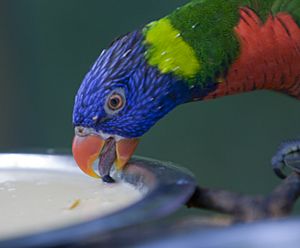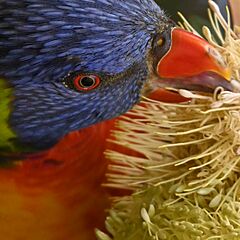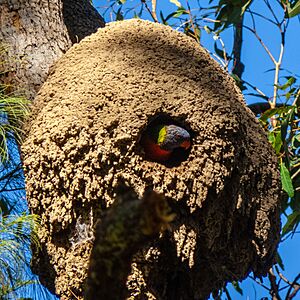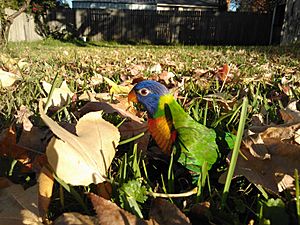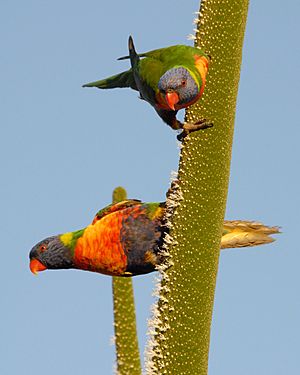Rainbow lorikeet facts for kids
Quick facts for kids Rainbow lorikeet |
|
|---|---|
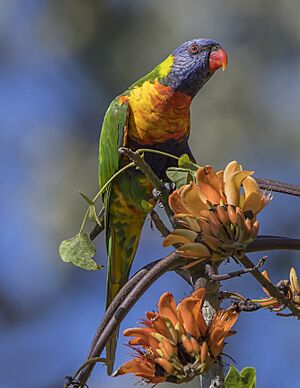 |
|
| Royal Botanic Gardens, Sydney | |
| Conservation status | |
| Scientific classification | |
| Genus: |
Trichoglossus
|
| Species: |
moluccanus
|
The rainbow lorikeet (its scientific name is Trichoglossus moluccanus) is a super colorful type of parrot that lives in Australia. You can often spot them along Australia's eastern coast, all the way from northern Queensland down to South Australia. These vibrant birds love living in places like rainforests, coastal bushes, and woodland areas.
Did you know that some birds that used to be called different types of rainbow lorikeets are now seen as their own separate species? It's like how different types of dogs are all dogs, but a poodle and a bulldog are still very different!
Rainbow lorikeets have also been introduced to other places by people, like Perth, Western Australia; Tasmania; Auckland, New Zealand; and Hong Kong. This means they weren't originally found there, but now they live and breed in these new locations.
Contents
Discovering the Rainbow Lorikeet
The rainbow lorikeet was officially described way back in 1788 by a German scientist named Johann Friedrich Gmelin. He gave it the scientific name Psittacus moluccanus. Gmelin thought these birds came from the Moluccas (which are islands in Indonesia), but later on, scientists realized they actually came from Botany Bay in Australia.
Today, the rainbow lorikeet is part of a group of birds called Trichoglossus, which was named by an English scientist, James Francis Stephens, in 1826.
Types of Rainbow Lorikeets
There are two main types, or subspecies, of the rainbow lorikeet that scientists recognize:
| Image | Subspecies Name | Where They Live |
|---|---|---|
| T. m. septentrionalis Robinson, 1900 | Cape York Peninsula (in northeast Australia) | |
 |
T. m. moluccanus (Gmelin, JF, 1788) | Most of Australia (but not Cape York Peninsula) and Tasmania |
Scientists sometimes change their minds about how to group animals as they learn more! For a while, the red-collared lorikeet was thought to be a type of rainbow lorikeet, but now most experts agree it's a separate species. More recently, in 2019, the rainbow lorikeets in Australia were even split into three different species: the rainbow lorikeet, the coconut lorikeet, and the red-collared lorikeet.
What Does a Rainbow Lorikeet Look Like?
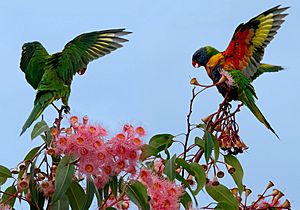
The rainbow lorikeet is a medium-sized parrot, usually about 25 to 30 cm (9.8 to 11.8 in) long, including its tail. They weigh about 75 to 157 g (2.6–5.5 oz). Their plumage (that's their feathers!) is incredibly bright and colorful, just like a rainbow!
- Their head is a deep blue.
- They have a greenish-yellow collar around their neck.
- Their wings, back, and tail are green.
- Their chest is a mix of orange and yellow.
- Their belly is a deep blue.
- Their thighs and rump are green.
When they fly, you can see a bright yellow stripe on their wings, which stands out against the red feathers underneath their wings. It's hard to tell the difference between male and female rainbow lorikeets just by looking at them because they look so similar!
Young lorikeets have a black beak, but as they grow up, their beak gradually turns orange.
How to Tell Them Apart from Similar Birds
Rainbow lorikeets look a lot like the coconut lorikeet, but the rainbow lorikeet has a blue belly and a more orange chest, usually without many blue-black stripes.
Are Male and Female Rainbow Lorikeets Different?
Unlike some other parrots where males and females look very different (like the eclectus parrot), rainbow lorikeets don't have any obvious differences between the sexes. Both males and females look exactly the same! If you really need to know if a lorikeet is male or female, you'd need a vet to do a special check or a DNA test using one of their feathers.
How Do Rainbow Lorikeets Behave?
Rainbow lorikeets often fly around in pairs. Sometimes, they'll all gather together in a big flock if they hear a call, but then they usually split back into their pairs. These pairs are quite protective of their feeding and nesting spots. They'll even chase away other rainbow lorikeets or different types of birds, whether they're smaller birds like the noisy miner or even bigger birds like the Australian magpie!
What Do Rainbow Lorikeets Eat?
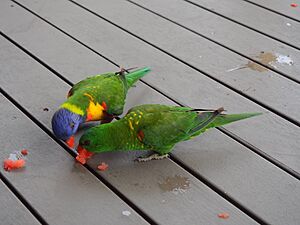
Rainbow lorikeets mainly eat fruit, pollen, and nectar. They have a very special tongue that's perfect for this diet! The end of their tongue looks like a little brush, which helps them collect pollen and nectar from flowers.
In Australia, they love the nectar from eucalyptus trees. Other favorite nectar sources include Pittosporum, Grevillea, the African tulip-tree (Spathodea campanulata), and the sago palm (Metroxylon sagu). In other parts of the world, like Melanesia, coconuts are a very important food source for them, and the lorikeets help pollinate the coconut trees!
They also eat fruits from trees like Ficus, Trema, and Muntingia, as well as papayas and mangoes that have already been opened by fruit bats. Sometimes, they'll even eat fruits from farms, like apples, and might raid fields of maize (corn) and sorghum.
You might also see them visiting bird feeders in gardens, where people offer them special nectar mixes, sunflower seeds, and fruits like apples, grapes, and pears.
Hand-Feeding Lorikeets
In many places, especially at campsites and in suburban gardens, wild rainbow lorikeets are so used to people that you can even hand-feed them!
The Currumbin Wildlife Sanctuary in Queensland, Australia, is famous for having thousands of lorikeets. Every day, around 8 AM and 4 PM, huge, noisy flocks of these birds gather in the park. Visitors are encouraged to feed them a special nectar, and the birds will happily sit on people's arms and heads to eat it! You can also hand-feed wild rainbow lorikeets at Lone Pine Koala Sanctuary in Brisbane, Queensland.
Many people in Sydney backyards also have semi-tame lorikeets visiting daily. However, it's important to know that feeding them bread or bread with honey isn't good for them. It doesn't give them all the nutrients, vitamins, and minerals they need, which can cause health problems, especially for young lorikeets. It's much better to use special packet mixes that are made to be healthy for lorikeets, which you can usually find at vets or pet stores.
-
Drinking Banksia nectar
-
Drinking Aloe nectar
-
Drinking Grevillea nectar
-
Drinking Erythrina crista-galli nectar
How Do Rainbow Lorikeets Raise Their Young?
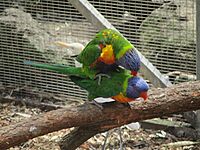
In southern Australia, rainbow lorikeets usually breed from late winter to early summer (around August to January). In other parts of Australia, they can breed almost any time of the year, depending on when food is available and what the weather is like.
They can make their nests in many different places, like hollows in tall trees (such as eucalypts), inside palm tree trunks, or under overhanging rocks. Interestingly, one group of lorikeets in the Admiralty Islands even nests in holes in the ground on small islands where there are no predators! Sometimes, several pairs of rainbow lorikeets might nest in the same tree, or even nest near other bird species.
A female lorikeet usually lays between one and three eggs. She sits on the eggs to keep them warm (this is called incubation) for about 25 days. Only the female does the incubating.
Rainbow lorikeets are mostly monogamous, which means they usually stay with the same partner for a long time, sometimes even for their whole lives!
Are Rainbow Lorikeets Endangered?
Overall, the rainbow lorikeet is very common and can be found in many places. According to the annual Birdlife Australia count, it's actually the most commonly seen bird in Australia! Because of this, BirdLife International considers them to be of least concern, meaning they are not currently at risk of extinction.
However, some local types of lorikeets might be in more trouble. For example, the Biak lorikeet (which some scientists think should be its own species) is threatened by habitat loss (when their homes are destroyed) and by being captured for the parrot trade.
Can Rainbow Lorikeets Be a Problem?
While they are beautiful, some fruit orchard owners see rainbow lorikeets as a pest. This is because the lorikeets often fly in large groups and can quickly strip trees of their fresh fruit. In cities, their noisy calls can be a nuisance, and their droppings can make outdoor areas and cars messy.
In Western Australia, rainbow lorikeets were accidentally released near the University of Western Australia in the 1960s. Since then, they've been classified as a pest there. They cause big problems by competing with local bird species for food and for the few available nesting hollows. This means native birds like the purple-crowned lorikeet, the Carnaby's black cockatoo, and the Australian ringneck can be negatively affected or even pushed out of their homes.
A group of wild rainbow lorikeets also started living in New Zealand after someone illegally released many captive birds there in the 1990s. By 1999, there were about 150–200 wild birds, showing they could survive and adapt. The New Zealand Department of Conservation was worried that these lorikeets would compete with native honeyeaters and threaten special island habitats. So, they started trying to get rid of the wild population in 2000. Now, different government groups work together to prevent rainbow lorikeets from becoming established in the wild in New Zealand.
Health Issues for Lorikeets
Lorikeet Paralysis Syndrome
Every year, a mysterious illness affects thousands of rainbow lorikeets in southeast Queensland and northeast New South Wales. The birds become paralyzed, meaning they can't fly or eat. This problem happens only at certain times of the year—from October to June, and most often from December to February. Because it's so seasonal, scientists think it might be caused by the birds eating a poisonous plant fruit that only blooms during those months.
See also
 In Spanish: Trichoglossus moluccanus para niños
In Spanish: Trichoglossus moluccanus para niños



